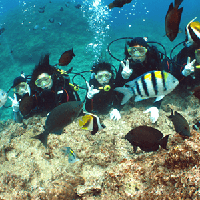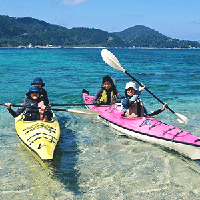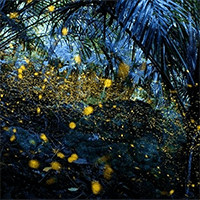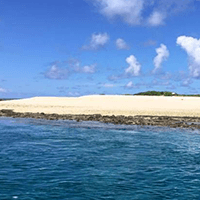- Age 6~Age 100
- 1~2 hours
- 09:00 / 13:00
The only thing that is fixed in the cans is Awajishima onions, but you can freely add seasonings and ingredients to the base recipe! You can put ingredients purchased in Awajishima (fish, meat, vegetables, anything is OK), seal the lid, sterilize, and attach a label of your choice, all by yourself, making your own original canned goods that are one of a kind in the world. Perfect as a souvenir, and even after you've received the contents, you can use them as room decor. At AINAS FOOD STYLE, you can experience making your own original canned goods that are "easy and delicious for anyone"! We have prepared a base recipe for onion soup using whole Awajishima onions to be canned, so all you have to do is add your favorite seasonings and ingredients! Why not try adding ingredients unique to Awajishima? For example, high-quality fish such as conger eel and 3-year-old tiger pufferfish, Awajishima Naruto oranges, Awaji beef and their processed products, souvenir sweets, or anything else is fine. You can also add curry flavor and other seasonings to create your own original flavor! Specialized staff will explain the specialized processes, such as how to seal the cans and how the sterilization process works, so there is no difficult work involved. The finished cans are finished with an original Awajishima Tourist Association label with a "Last Supper" motif, perfect for Miketsukuni. Write a message or memories for the person you want to give it to on the label and take it home as a souvenir for yourself or a loved one! Even after you've enjoyed the contents, they can also be used as room decorations. Why not create a one-of-a-kind souvenir by filling it with the excitement of the can-making experience and memories of your trip to "Miketsukuni Awajishima"? Experience Schedule [Duration: Approximately 1 hour and 30 minutes] 9:00-9:15 (13:00-13:15) Experience starts, change of clothes, explanation of canning process, etc. 9:15-9:30 (13:15-13:30) Preparing onions (wash hands, peel and cut onions) 9:30-9:55 (13:30-13:55) Cooking (fry onions and make soup) 9:55-10:00 (13:55-14:00) Packing soup and "whole onions" into cans (add condiments and toppings) 10:00-10:05 (14:00-14:05) Sealing and sealing the cans (putting the lids on the cans using a vacuum can seaming machine) 10:05-10:10 (14:05- 14:10) High-temperature sterilization begins in the sterilization cooking pot (*It takes about 100 minutes to complete sterilization) 10:10-10:30 (14:10-14:30) Cleaning, tidying up, writing and creating original labels
- Age 10~Age 80
- Within 1 hour /1~2 hours
Become a samurai wearing armor and have a Japanese sword experience filmed by a professional photographer! Learn how to use, draw and swing a sword in a real martial arts dojo, and at the end you can actually have a sword fight. An assistant will translate in English. You can enjoy a "demonstration and straw cutting" using a real Japanese sword with the true sword technique of Yuujin-ryu. A Yuujin-ryu sword technique holder from the Koryu Iaido dojo will safely and carefully instruct you, so you can participate in the experience with peace of mind. <Experience on the day of the plan> ・Greetings (brief self-introduction), instruction on things to be careful about during the experience, etc. ・Changing into a kagami (Japanese traditional sword) uniform ・Salute to the Shinto altar ・Bending and stretching exercises ・Instruction on swinging a replica or wooden sword ・Watch the head of the family's kata demonstration ・Watch straw cutting by a high-ranking holder ・Experience wearing armor ・Mock battle with a high-ranking holder ・Experience caring for a real sword ・Go to a sword shop and sell swords for appreciation The whole experience takes about 60 to 90 minutes
- Age 16~Age 60
- 2~3 hours
This is a premium photo experience plan for the traditional Japanese bride and groom. You will choose a real wedding outfit from a famous costume store, get ready at a studio salon in Kita-ku, Kyoto, and then wear a real wedding outfit of a crested hakama and a white or colored uchikake at a Japanese-style studio along the Kamo River, and the experience of being a bride and groom will be recorded in photos. The photo data will be delivered digitally on the day. You will receive a free L-size mini album! ~Experience flow~8:50 Meet at Grace Shiga Studio Salon, please wait 10 minutes beforehand. 9:00 Get ready, do your hair and makeup, and put on your kimono. 10:15 Finishing touches Indoor photo shoot begins as soon as preparations are completed10:30 Location photo shoot Move to Kamo River for location photo shoot11:00 Experience photo ends Return to the studio salon to change clothes
- Age 16~Age 60
- 2~3 hours
This is a standard plan for a traditional Japanese bride and groom experience photo shoot. You will get ready at a studio salon in Kita-ku, Kyoto, and then you will be dressed in authentic wedding attire consisting of a crested hakama and a white or colored uchikake kimono in a Japanese-style studio along the Kamo River, and your experience as a bride and groom will be recorded in photos. The photo data will be delivered digitally on the day. You will receive a free L-size mini album! ~Experience process~8:50 Meet at Grace Shiga Studio Salon, please wait 10 minutes beforehand. 9:00 Get ready, do your hair and makeup, and put on your kimono. 10:15 Finishing touches Indoor photo shoot begins as soon as preparations are complete10:30 Location photo shoot Move to the Kamo River for location photo shoot11:00 Experience photo shoot ends Return to the studio salon to change clothes
- Age 12~Age 90
- 1~2 hours /3~4 hours
Goshuin were originally used as proof of visiting temples and shrines. Recently, there is a "goshuin boom", and there are various elaborate goshuin. Artistry is also added to the red stamp. Therefore, you will make your own red stamp colored paper to commemorate your visit to Mt. Koya.
- Age 0~Age 100
- 1~2 hours
- 09:00 / 10:00 / 11:00 / 13:00 / 14:00 / 15:00 / 16:00
Awaji tiles have been around for 400 years since the Edo period. As one of the three major tile production areas in Japan, tiles are still being manufactured there. The craftsmen who make onigawara and decorative tiles by hand are called "onishi", and it is a valuable experience to be able to see the craftsmanship of the onishi, who know the soil. Awaji tiles have been around for 400 years since the Edo period. As one of the three major tile production areas in Japan, tiles are still being manufactured there. The craftsmen who make onigawara and decorative tiles by hand, which are indispensable for temples and shrines, are called "onishi", and their numbers are decreasing, with only about 10 on the entire island of Awaji (about 50 nationwide). Tatsumi Co., Ltd., which you will visit on this plan, has five onigawara. The factory tour is a private plan limited to one group per time. With the guidance of the potter's president, Okitsu Yusuke, you will observe the tile manufacturing process and the techniques used by the onigawara craftsmen to make the onigawara tiles. You will also be able to talk to the onigawara craftsmen, who will be happy to answer any questions you may have. Afterwards, in the exhibition area, valuable pieces made during the Azuchi-Momoyama period are on display, giving you a glimpse into the evolution of this traditional craft that has continued for 400 years. Another attraction is that all the onigawara craftsmen's works from the Azuchi-Momoyama period to the present day are on display in one place. After the experience, you will be given a souvenir aromatic tile to choose from and can take home with you. Below is the experience schedule. You will be guided through the tour as follows: 1. Manufacturing site 2. Onigawara craftsmen at work 3. Onigawara collection (exhibition area)
- Age 12~Age 100
- 1~2 hours
- 10:00 / 13:00
Surrounded by nature at the foot of a small hill, Shunyoso shows off the graceful expressions of the four seasons that are unique to Japanese-style architecture. The owner, who is also a certified old house appraiser, will guide you through the house and explain the traditional techniques that are difficult to reproduce today, the design that highlights the playfulness of the craftsmen, and the immeasurable historical and cultural value. After the tour, Shunyoso will quickly transform into a sweets shop. Enjoy an elegant moment with tea and Japanese sweets in an elegant space. Shunyoso is a masterpiece of modern Japanese architecture that was designed in 1941 by architect Toyoen Yamamoto, an authority on the study of home orientation, based on the ideas of feng shui, and was completed over a period of seven years by local carpenter Sankichi Saito and others. Further on, in 1983, the walls, gateposts, doors and gardens were renovated by architect Izue Hiroshi, who was even called a "master" by the famous architect Kurokawa Kisho, and they now harmonize beautifully to create a magnificent architectural landscape. The vast grounds of 1320m2 (approximately 1,400m2) contain eight buildings, including the guest house, storehouse, reception hall, sleeping hall and permanent residence, and in 2004 it was designated as a nationally registered tangible cultural property, and in 2017 it was designated as an important structure for the formation of the Hyogo Prefectural Landscape. However, with the aging of the population and a social trend in recent years that only pursues efficiency, it became difficult for the previous owner to maintain and manage the buildings, and they gradually deteriorated, leading to a long period of time when the gates were closed. The turning point came in 2015. In order to preserve this precious cultural asset for future generations, the fourth-generation owner purchased it and began repairs and renovations. Finally, in October 2016, Shunyo-so was revived and reborn as a new international tourist resource for Awaji Island. In this experience program, the owner himself will guide you through the house, explaining the charms of the house, such as the traditional techniques that are difficult to reproduce today, the building materials that are also difficult to obtain today, the designs that highlight the playfulness of the craftsmen scattered throughout, and the elegant furnishings, based on the historical background of Shunyo-so. Please enjoy this space, which is filled with history and culture and represents the best of traditional techniques, to the fullest. After the tour, you will be served tea and Japanese sweets in the tea room or one of your choice. Please enjoy not only as a precious cultural asset, but also as a sweet shop. *Guides in English are also available, so we can accommodate customers from overseas. *A five-minute walk from Shunyoso is the historic and prestigious "Takenoguchi Hachiman Shrine," which celebrated its 1,100th anniversary in 2021. Why not visit the shrine as well? You can also enjoy a stroll through the historical and atmospheric streets of the Takenoguchi area. Experience schedule (The schedule below starts at 10:00, but please read the time differently if starting at 13:00) 10:00 Meet on site 10:05 Check-in and briefing Guided tour of Shunyoso 11:00 Enjoy tea and Japanese sweets in the teahouse. 11:30 End
- Age 6~Age 100
- 2~3 hours
- 10:00 / 13:00 / 15:00
At Senkoji Temple, which boasts a history of 1100 years and has a temple on the summit of Sakiyama, a sacred mountain on Awaji Island, you can visit the main hall while enjoying the view of Sumoto City, one of the eight scenic views of Sumoto, and experience a sutra copying experience in a mysterious silence, which is an extraordinary experience. If you wish, you can also visit Iwato Shrine after the experience. Sakiyama, also known as Awaji Fuji, is said to be the first mountain created in Japan in the legend of the creation of the world by the gods Izanagi and Izanami. At Senkoji Temple, which has a temple on the summit of Sakiyama, you can experience copying sutras. First, you can climb about 200 steps to tour the grounds of Senkoji Temple, learn about the origins of Senkoji Temple, and see the place where the Awaji Island custom of "Dango Korogashi", which is rare nationwide, is performed at the temple. You will also be greeted by a lion-like boar, instead of a lion-dog, enshrined in front of the main hall. Because it is a temple on the mountaintop, you can see the central and southern part of Awaji Island, and if the weather is good, you can see the Naruto Strait and Wakayama. Return to the temple office and go to the "Daishido" to experience copying sutras. In copying sutras, you will copy the general Heart Sutra. Place the paper on top of the model Heart Sutra and copy it with a brush pen. Beginners are also welcome. By copying the characters in a solemn space, you can spend a valuable time reflecting on yourself. You can donate the copy to the temple or take it home. After the experience, you can also visit "Iwato Shrine", a popular power spot that enshrines a huge rock where Amaterasu Omikami hid herself, about 10 minutes down from the temple. (Please note that this is a full-scale mountain path) Experience schedule (for example, if the tour starts at 13:00) Meet at 13:00 *Walk around the temple grounds, including visiting the main hall (guided by the head priest Okazaki) 14:00 Experience copying sutras at the Daishido (approx. 30 minutes to 1 hour) 15:00 Scheduled end *After the tour, you can walk around the temple grounds and visit Iwato Shrine (on your own). It takes about 10 minutes to walk one way up the mountain path to Iwato Shrine.
- Age 4~Age 99
- 2~3 hours
- 17:00
This is a class where you can experience Japanese home cooking. [Menu] ・Japanese rice cooked in a clay pot ・Tempura (shrimp, vegetables, mushrooms, etc.) ・Teriyaki fried tofu ・Miso soup ~Experience flow~ 16:55 Everyone washes their hands Before the cooking experience, wash your hands thoroughly. 17:00 We will start cooking all four dishes with the instructor, who will explain them to you in detail. We will also give you the recipes for the dishes. 18:30 Tasting Taste the dishes you have finished making on the spot. You can also order alcohol or soft drinks (additional charge). 19:30 Thank you for the meal! This is the end of the experience class. If you finish eating early, you can leave without waiting for the end time.
- Age 12~Age 100
- 2~3 hours
- 10:00 / 14:00
Naohara Gyokusei is a master of Nanga painting who grew up on Awaji Island. He is also a Rinzai Obaku sect monk, and at Kokusei Zenji Temple, which he rebuilt, you can enjoy a beginner-friendly zazen experience and appreciate Gyokusei's friendly Nanga paintings that he personally painted. After the 60-minute zazen experience, you will listen to the current chief priest explain the Zen teachings contained in Gyokusei's works while drinking tea, then move to Minami Awaji City Takikawa Memorial Museum Gyokuseikan (5-minute walk) and view the diverse works of Naohara Gyokusei that are housed in the museum. This is a special experience that expresses the trinity of Nanga, haiku, and Zen, and allows you to feel the spirit of "kugazenichinyo" and reflect on yourself. Naohara Gyokusei is a master of Nanga painting who has ties to Awaji Island. He was also a painter and haiku poet, and a Rinzai Obaku sect monk, and became the chief priest to rebuild the dilapidated Zen temple Kokusei-an (later Kokusei Zenji) on Awaji Island where he grew up. At Kokusei Zenji Temple, which was magnificently rebuilt by Gyokusei, you will first complete a beginner-friendly zazen experience (about 60 minutes), after which you will listen to the current head priest explain the Zen teachings contained in Gyokusei's works while drinking tea, and then view Gyokusei's intimate works, which are privately painted by Gyokusei and housed in a storehouse within the temple grounds. You will be able to view rare sliding door paintings and other works up close without any partitions. After that, you will move to the Takikawa Memorial Museum of Art Gyokuseikan (about a 5-minute walk, 200m), where many of Gyokusei's paintings are on display, and finally view the masterpieces housed in the museum's collection. You will be able to experience a special time to reexamine yourself through the spirit of "Kuga Zen Ichinyo," which expresses the trinity of Nanga, haiku, and Zen that Naohara Gyokusei loved.
- Age 13~Age 90
- 2~3 hours
- 12:00
A historically designed Kyoto townhouse can be rented exclusively for four or more people. You can spend a luxurious time. You can enjoy a special and unique experience of watching the beautiful dance of the maiko, traditional Japanese games, and Japanese cuisine prepared by a chef to your heart's content. Enjoy an elegant time with your family and loved ones in a secluded space. After watching the performance, you can enjoy matcha tea and Japanese sweets with the maiko and take photos. Please feel free to spend your time while enjoying the elegant Kyoto dialect of the maiko.
- Age 6~Age 70
- 2~3 hours
- 10:00 / 14:00 / 17:00
You can make anpan, a type of bread often eaten by Japanese people, in a Japanese home in 2 hours using a domestic oven. Even beginners are OK! We will teach you how to make bread carefully. Children of elementary school age and above can participate. Reservations can be made for up to 4 people. You may be impressed by the fluffy, freshly baked anpan! You can knead the dough by hand or by machine, so it's interesting to see how the dough changes!
最近チェックしたプラン
Please wait a moment
![[Hyogo・Sumoto] Make your own original canned food that is unique to Awaji Island! Add your favorite seasonings and ingredients to the soup made with Awaji Island onions!の画像](https://img.activityjapan.com/10/58612/10000005861201_1Gz5AIDf_3.webp?version=1744094222)
![[Osaka, Kyobashi] Japanese sword, swordsmanship, and match experience Limited time only! Japanese sword, swordsmanship, and match experience wearing armor "Shogun photo course"の画像](https://img.activityjapan.com/10/57887/10000005788701_nEpeDKrj_3.jpg?version=1740113146)
![[Kyoto] Traditional Japanese Bride and Groom Experience Photo Premium Planの画像](https://img.activityjapan.com/10/58245/10000005824501_1Gz5AIDf_3.jpg?version=1743509523)
![[Kyoto] Traditional Japanese Bride and Groom Experience Photo Standard Planの画像](https://img.activityjapan.com/10/58244/10000005824401_1Gz5AIDf_3.jpg?version=1741772822)
![[Wakayama / Koyasan] Making good luck colored paper using red stampsの画像](https://img.activityjapan.com/10/43540/10000004354001_mF6wAgG0_3.jpg?version=1659583864)
![[Hyogo, Minami Awaji] 400 years of history! Japan's three major tile production areas: Onigawara craftsmen on Awaji Island: Experience the craftsmanship of Onishi up close and see the manufacturing process! Awaji tile kiln tour experienceの画像](https://img.activityjapan.com/10/58514/10000005851401_1Gz5AIDf_3.webp?version=1743490147)
![[Hyogo, Sumoto] <Nationally Registered Tangible Cultural Property> The elegant Japanese-style building "Shunyoso" is imbued with the power of Feng Shui. Immerse yourself in the tasteful and precious historical and cultural space.の画像](https://img.activityjapan.com/10/58456/10000005845601_1Gz5AIDf_3.webp?version=1743128703)
![[Hyogo, Sumoto] Experience something out of the ordinary at Senkoji Temple, located on Sakiyama, which is said to be the first mountain to be created in Japan in the "creation mythology" <copying sutras experience>の画像](https://img.activityjapan.com/10/58443/10000005844301_1Gz5AIDf_3.webp?version=1743129423)
![[Kyoto, Sakyo Ward, Kyoto City] Completely private! Japanese home cooking experienceの画像](https://img.activityjapan.com/10/56387/10000005638701_AVWlGGNt_3.jpg?version=1727405222)
![[Hyogo, Minami Awaji] Experience Zen meditation and appreciating the Nanga paintings of Gyokusei Jikihara at a Zen temple associated with the master of Nanga painting who grew up on Awaji Island.の画像](https://img.activityjapan.com/10/58500/10000005850001_1Gz5AIDf_3.webp?version=1743403386)
![[Kyoto, Nishijin] Kyoto Machiya plan limited to one group per day: "Kyoto cuisine, playing with a maiko, tea ceremony and Japanese sweets"の画像](https://img.activityjapan.com/10/55967/10000005596701_nfpLyiSA_3.jpg?version=1732536362)
![[Osaka, Tenma (Umeda area)] Experience making uniquely Japanese sweet bean buns in a Japanese home for 2 hours + tasting! (Beginners welcome, empty-handed)の画像](https://img.activityjapan.com/10/59657/10000005965701_mPsWLCPt_3.JPG?version=1749621424)







